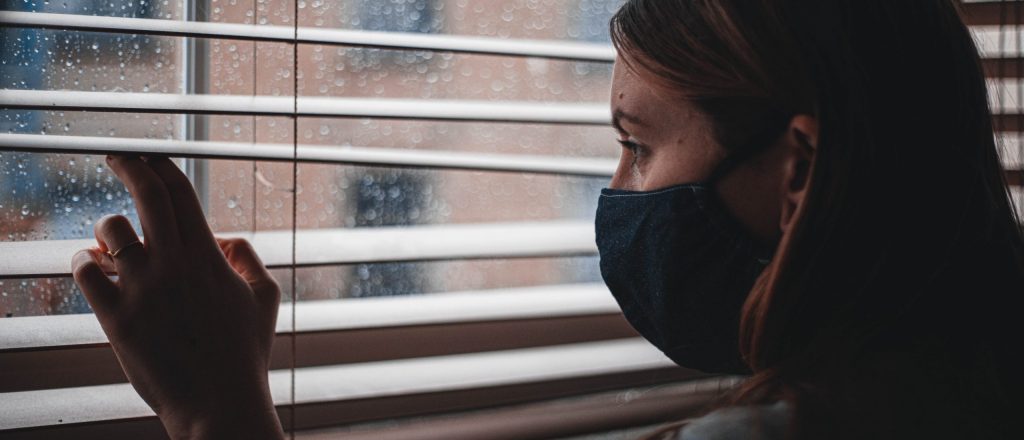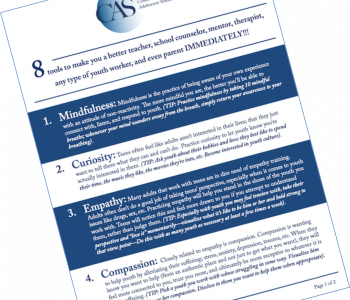

Sam Himelstein, PhD
Sam Himelstein is the founder and CEO of the Center for Adolescent Studies, Inc. He is passionate about working with youth and training the professionals that serve them.
3 Ways to Help Youth with the Emotional Impact of the Pandemic
We’ve all seen the photos of spring breakers gathering at crowded parties, in defiance of social distancing recommendations. Those types of images might make it seem that all youth are blithely unaware of the impacts of COVID, but that’s far from the truth. In fact, the pandemic has had a much bigger impact on youth than many people realize.
Teens and young adults have been dealing with:
- Disrupted schooling: For many teens it’s been challenging not having a predictable routine, as school districts have swung back and forth from in-person to online learning. Other kids have done very well with online learning and feel anxious about going back into the classroom. And some youth haven’t had access to the necessary technology to keep up with their schoolwork, or have been responsible for supervising younger siblings while trying to keep up with their own studies.
- Social Isolation: Kids haven’t just been lonely from not being able to hang out with their friends. They’ve also missed out sports, drama club, after-school activities, and other key venues for developing social skills.
- Loss of Newfound Independence: Older teens and young adults are individuating and becoming more autonomous. Many youth had to move back home after going away to college or because of losing their jobs, just as they were starting to develop their own separate identities.
- Family tensions: During quarantine and shelter-in-place, kids were spending far more time with their parents and siblings than usual. Some families bonded; they enjoyed having more family time and a chance to do things they normally wouldn’t have done together. But for many other families, being stuck together brought out underlying conflicts and escalated an already tense situation.
- Unemployment: For many youth, losing their hospitality or retail jobs means another missed opportunity to build social skills. Other young people and their families depend on their income, and have been struggling with food insecurity and how to pay the rent.
- Grief for Loved Ones and Lost Rites of Passage: It’s been a devastating year for many young people. Some had parents or grandparents die from COVID. Others feel a deep sense of loss because they’ve missed out on key rites of passage like the prom and graduation
Even after things get back to normal, many youth will still be struggling emotionally for a long time to come. Here are a few ways parents and other adults can help.
1) Treat Them as Budding Adults, Not Little Kids
In Uncommon Sense for Parents with Teenagers Dr. Mike Riera explains that when children are infants and toddlers, their parents have complete control over them. As the kids get older, their parents need to loosen the reins and allow for more autonomy. That’s a difficult concept for a lot of the parents to wrap their heads around, and I spend a lot of time on this with the families I see in therapy.
What teens are looking for, especially older teens, is for somebody who’s more of a consultant or coach rather than a micromanager. It can lead to tensions when the adults in their lives (parents, teachers, counselors, etc.) treat youth as if they’re much younger than they really are.
When there’s a boundary that needs to be set, tensions can escalate if you say something like ‘Stop doing this” or “You can’t do that.” It’s much more effective to engage youth in finding solutions together so they don’t feel bossed around.
For example, during quarantine, rather than ordering kids not to see their friends, it was much more effective for parents to discuss with them, “How can you be connected socially with your friends even if you can’t physically be together?”
When you change that tone with them, it’s like a breath of fresh air – I’ve actually seen some of my teen clients in family therapy take a sigh in relief when they realize the adults are actually listening to their point of view.
2) Model Mindfulness and Resilience
If you’re not taking care of yourself, you’re more likely to be stressed out all the time. That can make you more reactive, which can have a negative influence on the whole family system or your whole class or group.
Conversely, if you are taking care of yourself, it can have a positive impact because you’re able to communicate more calmly. You’re also modeling healthy ways to handle stress and conflict, which will have a positive long-term impact on the youth who are under your care. (And even if they never seem to be listening, young people always notice when adults are being excessively reactive.)
Practicing mindfulness can be a self-care tool and a way to practice inner resilience. We can’t always control when we feel angry, or anxious, or frustrated, and so on. But we can learn to have a better handle on our reactions.
The definition of mindfulness I like to use is: Present-moment awareness with an attitude of non-reactivity.
Formal mindfulness meditation means following a particular mental strategy. There are a variety of ways to do this; many people find it helpful to start by learning to become aware of their breath (in the nostrils, in the belly, or in the chest). Then, whenever your mind wanders–which will definitely happen –bring your attention back to the breath. You could start by doing this for just one or two minutes and then maybe eventually try it for 15 or 20 minutes.
There are also a lot of ways to practice mindfulness informally throughout the day. One technique is to pause for a moment and ask yourself, How do I feel right now? Then take a couple of moments to be authentic and honest with yourself about whatever comes up for you.
Instead of pushing away that feeling and pretending not to be angry or frustrated or sad, you’re facing it head on and accepting that it’s there. And then you can decide how to express that feeling.
When you’re having a tough experience, oftentimes one of the things that makes it harder is your self-criticism or resisting the experience: “I hate feeling like this. This experience is terrible.” That adds a layer of judgment, which will likely leave you feeling even worse.
Part of mindfulness is learning how to peel that layer back and just experience your feelings without judging them. This can be challenging, but it’s something that you can get better at with practice.
3) If Appropriate, Teach Formal or Informal Mindfulness Practices
If you find certain types of meditation or other mindfulness practices helpful, you might want to share them with youth. It’s important to build an authentic relationship first before recommending a specific mindfulness technique. If you have a rapport of receptivity and trust, you’re much more likely to get buy-in, and to understand that individual well enough to make appropriate recommendations.
You could say something like:
“Hey, I know you’ve been struggling with X, Y, or Z lately. When I’m feeling stressed/anxious/overwhelmed, there’s something I do that I’ve found really helpful. Do you think you might want to give it a shot?”
If they have a good rapport with you, most youth will at least be willing to try what you suggest. Be sure to explain clearly that mindfulness means present-moment awareness with an attitude of non-reactivity (or whatever phrasing is authentic to you). When I teach mindfulness to youth, I’ve found two techniques particularly helpful: “Cultivating the Lion Mind” and ‘Still Chillin.’
A lot of youth have the misconception that mindfulness means taking deep breaths and feeling calm. So if they don’t feel calm, they may think, “I can’t do this meditation thing. I’m not good at it, or it doesn’t work.” If they understand that mindfulness means present-moment awareness with an attitude of non-reactivity, then whatever they’re experiencing during meditation, that’s OK. If they feel angry or anxious or if they’re having a flurry of thoughts—whatever it is, that’s OK.
You can also help them think of ways to practice mindfulness in daily life. If they think about “present-moment awareness with an attitude of non-reactivity,” they can come up with ways to bring that awareness into the daily tasks and activities they’re already doing.
Conclusion
With the multiple stressors from the pandemic, many youth are struggling with depression and anxiety.
The best results I’ve seen with my clients come from:
- Acting more like a life coach, helping them meet their own goals rather than lecturing them and telling them what to do;
- Modeling positive coping skills; and
- Teaching them mindfulness techniques that resonate for them, rather than a one size fits all approach.
You can find more suggestions in the following posts:
- 4 Tips for Helping Youth During Times of Crisis and Confusion
- 4 Qualities That Lead to Interpersonal Connection and Safety with Youth
- 9 Guidelines for Teaching Trauma-Informed Mindfulness to Teens
- 4 Ways to Improve Difficult Relationships with Youth
You might also benefit from Heart Spring, an online community for helping professionals to continually evolve self-care and resilience practices, learn skills to bring to those they work with, and connect to a larger helping community.
Your Turn: How has COVID impacted the young people in your life? What strategies have you found more/less effective in helping them? Share your tips and experiences in the comments.

